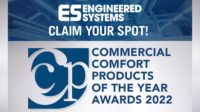As of January 1, 2020, the EPA made it illegal to import or manufacture the common refrigerant Freon, also known as R-22, in the U.S. — a major problem for facilities still using it. Many of those facilities have resorted to obtaining R-22 through recovered or recycled supplies. As that stockpile dwindles, however, the cost of the increasingly scarce synthetic refrigerant is growing exponentially. Facilities still using Freon are facing a predicament: switch to an alternative now or continue paying high prices until they no longer have a choice. Let’s explore why going through the conversion may be less daunting than many facility owners and managers think.
As a temporary solution, some facilities have opted for synthetic blend alternatives, including those using R-134a or R-410a as a base. But it’s likely a matter of time before those synthetic options are phased out as well, forcing those facilities to convert again.
Natural refrigerants like ammonia are among the best R-22 replacement options due to their low global warming potential (GWP). Ammonia has developed a bad reputation in some sectors due to persistent misconceptions about its safety, but it’s actually among the safest refrigerants when appropriately implemented.
The safety regulations surrounding ammonia in industrial refrigeration are far more stringent than those for R-22, reflecting the importance of monitoring and controlling ammonia use. Unlike Freon, which is odorless and can leak unnoticed until significant amounts have escaped, ammonia has a distinct, strong odor that serves as an early warning signal. This odor allows for the immediate detection of leaks, enabling quick response and minimizing potential hazards. Ammonia’s noticeable scent ensures that any issues are identified and addressed long before they pose a serious risk, making it a safer option in environments where safety is paramount.
In addition, ammonia is more efficient than R-22. At a temperature of 5°F, a pound of ammonia
can absorb 565 Btu (British thermal units) of heat. By comparison, R-22 only absorbs about 69
Btu per pound at the same temperature. That means less ammonia is required to achieve the
same amount of refrigeration; therefore, the system uses less electricity and costs less to operate.
Some facility owners are building decentralized ammonia systems separate from the main building to reduce employee exposure. These systems often use glycol and water to neutralize ammonia’s risk, a reassurance for facility owners who are hesitant to switch to ammonia because of safety concerns.
Stellar has designed and installed ammonia systems in a variety of commercial and industrial applications, including one for a Tropicana processing facility. In that case, the refrigeration system is housed in a decentralized location separate from production lines. A “scrubbing” system can immediately contain and mitigate an unexpected ammonia leak, and by switching from R-22 to cheaper and much more plentiful ammonia, Tropicana realized significant long-term cost savings.
Rob Perkins has more than 18 years of experience in the industrial refrigeration industry. He is a director of aftermarket sales at Stellar, a fully integrated design, engineering, construction, refrigeration, and mechanical services firm serving commercial, industrial, and public sector markets across the United States.




